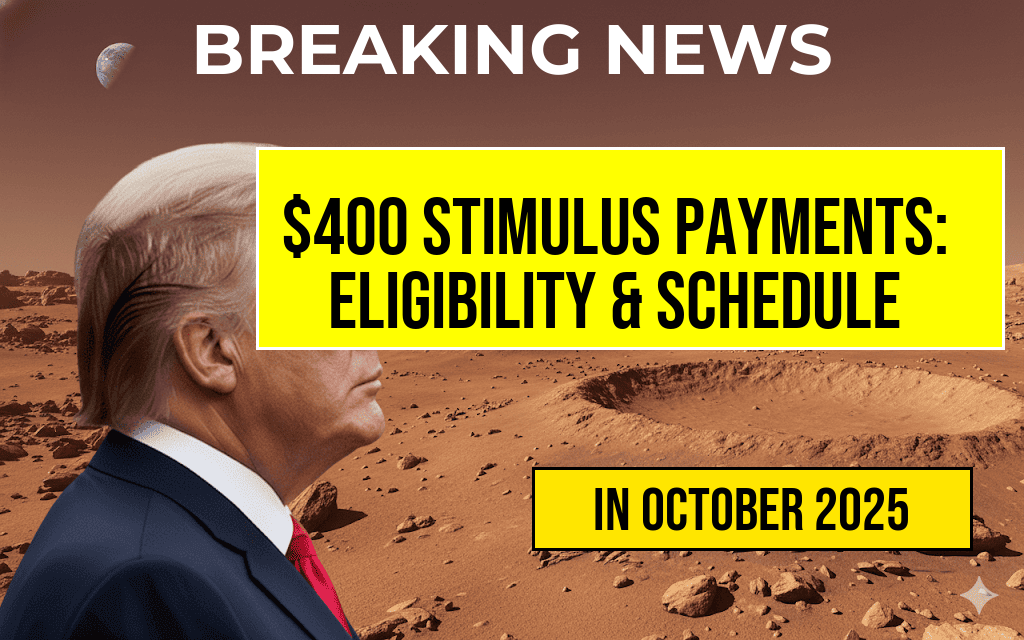A recent government initiative has announced a stimulus payment of $400 available to eligible individuals nationwide. This initiative aims to provide financial relief amidst ongoing economic challenges, with the payments scheduled to be distributed over several weeks. Eligibility criteria are straightforward but specific, ensuring that the funds reach those most in need. The complete payment schedule has been outlined by authorities, offering clarity on when recipients can expect their deposits. This article details the eligibility requirements, the payment timeline, and how eligible residents can ensure they receive their stimulus funds promptly.
Overview of the $400 Stimulus Payment Program
The stimulus program, announced by federal and state agencies, is designed to inject financial assistance directly into the pockets of Americans facing economic hardships. Eligible recipients can receive up to $400 per individual, with some states offering additional benefits or supplemental payments based on local budgets and policies. The initiative is part of broader efforts to stabilize household finances, support local economies, and alleviate burdens caused by inflation and other economic pressures.
Eligibility Requirements
Basic Criteria
- Residency: Must be a resident of the state or jurisdiction offering the stimulus payment.
- Income Limits: Income must fall below a specified threshold, typically around $75,000 for individuals or $150,000 for married couples filing jointly.
- Tax Filing Status: Must have filed a 2022 or 2023 tax return, or be registered through the state’s non-filer portal if income was below filing thresholds.
- Age: Applicants must be 18 years or older.
Additional Considerations
- Dependents: Payments generally do not include additional funds for dependents, though some states may offer supplementary benefits.
- Recent Residency: Individuals must have established residence within the qualifying jurisdiction by a certain date, often before a specified deadline.
- Legal Status: Both U.S. citizens and qualifying non-citizens may be eligible, provided they meet other criteria.
Application Process and How to Confirm Eligibility
Most jurisdictions have streamlined application procedures, often involving online portals or direct data matching with tax records. Residents are advised to check their state’s official website for precise instructions. For those who have already filed taxes or registered with the state’s portal, eligibility verification can often be completed automatically, and payments issued without additional steps. Individuals uncertain about eligibility are encouraged to consult official resources such as the IRS or their state’s revenue department.
Steps to Ensure Receipt of Payment
- Verify your residency status and income level based on official criteria.
- Ensure your latest tax return has been filed and processed.
- Update any relevant personal information on state portals to prevent delays.
- Register for direct deposit if possible, to receive funds faster than check mailings.
Payment Schedule and Distribution Timeline
| Distribution Phase | Estimated Date Range | Notes |
|---|---|---|
| Initial Payments | Starting late March 2024 | Recipients with verified eligibility receive funds first. |
| Secondary Wave | April 2024 | Remaining eligible residents, including late-registrants, receive payments. |
| Final Distributions | May 2024 | Last batch of payments, ensuring all eligible individuals are covered. |
Additional Support and Resources
Recipients seeking further assistance can access comprehensive guidance through official government portals or trusted financial advisory services. State-specific details, including eligibility verification and application procedures, are typically available on respective revenue or treasury websites. For general information about federal stimulus efforts, the Wikipedia page on stimulus packages provides valuable context. Additionally, financial news outlets such as Forbes frequently update coverage on ongoing relief initiatives and related economic policy developments.
As the distribution dates approach, residents are encouraged to monitor official channels for updates. Ensuring that personal information is current and verifying eligibility early can help avoid delays or missed payments. This direct financial support aims to bolster household stability during a period of economic adjustment, with authorities emphasizing transparency and accessibility throughout the process.
Frequently Asked Questions
Question
Who is eligible to receive the $400 stimulus payment?
Question
What are the eligibility requirements to qualify for the $400 stimulus payment?
Question
When will the payment schedule be announced and payments distributed?
Question
How can recipients check their payment status or confirm receipt of the $400 stimulus payment?
Question
Are there any exceptions or special cases that might affect eligibility for the stimulus payment?






